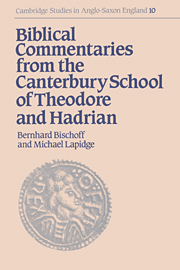Book contents
- Frontmatter
- Contents
- Preface
- List of abbreviations
- 1 Introduction
- 2 Archbishop Theodore
- 3 Abbot Hadrian
- 4 Theodore and Hadrian in England
- 5 The sources of the Canterbury biblical commentaries
- 6 The nature of the Canterbury biblical commentaries
- 7 The manuscripts
- Texts and translations
- Commentary to the texts
- Appendix I Additional manuscript witnesses to the Milan biblical commentaries
- Appendix II Two metrological treatises from the school of Canterbury
- Fig. 1 Cilicia and Syria
- Fig. 2 Constantinople in the seventh century
- Fig. 3 Churches and monasteries of seventh-century Rome
- Fig. 4 Cyrenaica and the Pentapolis
- Fig. 5 Campania and the Bay of Naples
- Fig. 6 Palestine
- Bibliography
- Index of Old English words quoted in the texts
- Index of Greek words quoted in the texts
- Index of names cited in the texts
- General index
5 - The sources of the Canterbury biblical commentaries
Published online by Cambridge University Press: 08 January 2010
- Frontmatter
- Contents
- Preface
- List of abbreviations
- 1 Introduction
- 2 Archbishop Theodore
- 3 Abbot Hadrian
- 4 Theodore and Hadrian in England
- 5 The sources of the Canterbury biblical commentaries
- 6 The nature of the Canterbury biblical commentaries
- 7 The manuscripts
- Texts and translations
- Commentary to the texts
- Appendix I Additional manuscript witnesses to the Milan biblical commentaries
- Appendix II Two metrological treatises from the school of Canterbury
- Fig. 1 Cilicia and Syria
- Fig. 2 Constantinople in the seventh century
- Fig. 3 Churches and monasteries of seventh-century Rome
- Fig. 4 Cyrenaica and the Pentapolis
- Fig. 5 Campania and the Bay of Naples
- Fig. 6 Palestine
- Bibliography
- Index of Old English words quoted in the texts
- Index of Greek words quoted in the texts
- Index of names cited in the texts
- General index
Summary
In the preceding chapters, we have seen that Theodore and Hadrian brought to England a vast experience of Mediterranean literary culture, in Latin, Greek and Syriac. It is time to examine the extent of that culture as it is reflected in the sources of the Canterbury biblical commentaries. These may be treated, for convenience, under the headings biblical sources, Latin patristic sources, Greek sources and Syriac sources.
BIBLICAL SOURCES
The first and most obvious source is the text of the Bible itself. Even cursory collation shows that the text which underlies the Canterbury commentaries is Jerome's Vulgate: indeed, the commentary on the Pentateuch begins with discussion of Jerome's own prologus to that text (PentI 1–16). Because of the early date of the commentaries, the biblical lemmata which they preserve bear witness to a stage of transmission earlier than all but the very few earliest biblical manuscripts; they thus assume an importance in their own right for biblical scholarship. This is not the place to undertake an exhaustive examination of the lemmata (Richard Marsden has fully investigated the Pentateuch lemmata, and Patrick McGurk the gospel lemmata, in forthcoming articles). A few preliminary observations may nevertheless be helpful. In what follows it will be convenient to treat the Pentateuch independently of the gospels, since these parts of the Bible were normally transmitted separately (and have separate transmissional histories), and since it is most unlikely that a pandect such as the Codex Amiatinus would have been used for teaching purposes in an Anglo-Saxon classroom.
- Type
- Chapter
- Information
- Publisher: Cambridge University PressPrint publication year: 1995

